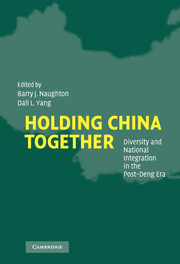Book contents
- Frontmatter
- Contents
- List of Figures and Tables
- List of Contributors
- Acknowledgments
- Holding China Together: Introduction
- PART ONE THE INSTITUTIONS FOR POLITICAL AND ECONOMIC CONTROL: ADAPTATION OF A HIERARCHICAL SYSTEM
- PART TWO CASE STUDIES OF POLICY IMPLEMENTATION
- 5 Policy Consistency in the Midst of the Asian Crisis: Managing the Furloughed and the Farmers in Three Cities
- 6 Population Control and State Coercion in China
- 7 The Political Economy of Industrial Restructuring in China's Coal Industry, 1992–1999
- 8 The Western Development Program
- Index
5 - Policy Consistency in the Midst of the Asian Crisis: Managing the Furloughed and the Farmers in Three Cities
Published online by Cambridge University Press: 08 December 2009
- Frontmatter
- Contents
- List of Figures and Tables
- List of Contributors
- Acknowledgments
- Holding China Together: Introduction
- PART ONE THE INSTITUTIONS FOR POLITICAL AND ECONOMIC CONTROL: ADAPTATION OF A HIERARCHICAL SYSTEM
- PART TWO CASE STUDIES OF POLICY IMPLEMENTATION
- 5 Policy Consistency in the Midst of the Asian Crisis: Managing the Furloughed and the Farmers in Three Cities
- 6 Population Control and State Coercion in China
- 7 The Political Economy of Industrial Restructuring in China's Coal Industry, 1992–1999
- 8 The Western Development Program
- Index
Summary
As marketization of the economy and a concomitant decentralization of economic decision making became increasingly entrenched after 1980, new factors appeared, both political and economic, that determined a place's possibilities for growth, instead of – as in the past – its position in the state plan alone had. Thus, the provinces became much more diverse economically than they had ever been in the previous three decades, with growth in those along the coast markedly more successful than that in the provinces in the interior.
In accord with this drive to marketize, at the 1997 15th Congress of the Chinese Communist Party, the leadership at last announced a mammoth project of worker cutbacks in a sudden push for enhanced enterprise efficiency. A few quotations from the following year embrace this spirit. On the domestic economy, a book on Liaoning makes this allegation:
To meet market economic demand, industrial enterprises must continue to reduce staff and increase efficiency to raise their productivity. Taking a long view, this will promote economic development, and eventually provide more employment opportunities, but in the short term we can't absorb new labor but instead the demand for labor will decline.
On the international economy, a major labor journal gives this caution:
We must optimize the investment environment … raise the ability to absorb foreign:apital. [For this] lowering labor costs is decisive.
Indeed, the switch from plans to markets did not just mean relinquishing planning domestically.
- Type
- Chapter
- Information
- Holding China TogetherDiversity and National Integration in the Post-Deng Era, pp. 149 - 192Publisher: Cambridge University PressPrint publication year: 2004
- 1
- Cited by



